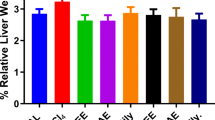Abstract
While Acer tegmentosum M. (AT) has been widely used as a popular folk remedy to prevent or treat liver diseases in Korea, the scientific evidences for the usage of AT against liver disease are poorly documented. To address this issue, we compared hepatoprotection of hot water extract (WEAT) from three parts of AT, boughs (E1), twigs (E2), and leaves (E3), on CCl4-induced acute hepatic injury in mice by way of morphometric and biochemical examination: liver function test, antioxidant enzymes activity of liver, histopathological and ultrastructural examination of liver, and antioxidant capacity (DPPH assay) of WEAT. We found that only oral intake group of WEAT-boughs showed significant differences in aspartate transaminase (AST), alanine transaminase (ALT) levels and glutathione peroxidase (GPx) activities as compared to CCl4 control group, whereas the glutathione levels were significantly low in all WEAT-pretreated groups. Consistently, histopathological and ultrastructural findings displayed hepatoprotection in the order of WEAT-boughs >WEAT-twigs>WEAT-leaves. Collectively, these results indicate that of three WEAT, WEAT-bough extract has the highest hepatoprotection against CCl4-induced acute hepatic injury in mice via the possible regulation of antioxidant enzyme activities in liver.
Similar content being viewed by others
References
Shin, K. C. et al. The physical and chemical properties and cytotoxic effects of Acer tegmentosum Maxim extract. J Korean Soc Appl Biol Chem 49:322–327 (2006).
Hong, B. K. et al. Biological activities and bioactive compounds in the extract of Acer tegmentosum Maxim Stem. Korean J Med Crop Sci 15:296–303 (2007).
Yu, T. et al. In vitro and in vivo anti-inflammatory effects of ethanol extract from Acer tegmentosum. J Ethnopharmacol 128:139–147 (2010).
Kwon, H. N., Park, J. R. & Jeon, J. R. Antioxidative and hepatoprotective effects of Acer tegmentosum M. extracts. J Korean Soc Food Sci Nutr 37:1389–1394 (2008).
Weber, L. W., Boll, M. & Stampfl, A. Hepatotoxicity and mechanism of action of haloalkanes: carbon tetrachloride as a toxicological model. Crit Rev Toxicol 33:105–136 (2003).
Recknagel, R. O. & Glende, W. A. Carbon tetrachloride hepatotoxicity: an example of lethal cleavage. CRC Crit Rev Toxicol 2:263–297 (1973).
Slater, T. F. Free-radical mechanisms in tissue injury. Biochem J 222:1–15 (1984).
Jeong, S. Y. et al. Toxicogenomics study on carbon tetrachloride-induced hepatotoxicity in mice. Mol Cell Toxicol 1:257–280 (2005).
Kim, S. I., Sim, K. H. & Choi, H. Y. A comparative study of antioxidant activity in some Korean medicinal plant used as food materials. Mol Cell Toxicol 6: 279–285 (2010).
Lobenhofer, E. K. et al. Application of visualization tools to the analysis of histopathological data enhancees biological insight and interpretation. Toxicol Pathol 34:921–928 (2006).
Tasci, I. et al. Ultrastructural changes in hepatocytes after taurine treatment in CCl4 induced liver injury. World J Gastroenterol 14:4897–4902 (2008).
Jefferies, H. et al. Glutathione. ANZ J Surg 73: 517–522 (2003).
Sharma, R. et al. Antioxidant role of glutathione Stransferases: protection against oxidant toxicity and regulation of stress-mediated apoptosis. Antioxid Redox Sign 6:289–300 (2004).
Ursini, F., Maiorino, M. & Gregolin, C. The selenoenzyme phospholipid hydroperoxide glutathione peroxidase. Biochim Biophys Acta 839:62–70 (1985).
Hur, J. M. et al. Isolation of isoprenoidal compounds from the stems of Acer tegmentosum Max. Korean J Pharmacol 38:67–70 (2007).
Hur, J. M. et al. Isolation of phenolic glucosides from the stems of Acer tegmentosum Max. J Korean Soc Appl Biol Chem 49:149–152 (2006).
Park, K. M. et al. Cytotoxic phenolic constituents of Acer tegmentosum Maxim. Arch Pharm Res 29:1086–1090 (2006).
Tung, N. H. et al. Total peroxyl radical-scavenging capacity of the chemical components from the stems of Acer tegmentosum Maxim. J Agr Food Chem 56: 10510–10514 (2008).
Deng, X. et al. Inflammatory stress and idiosyncratic hepatotoxicity: Hints from animal model. Pharmacol Rev 61:262–282 (2009).
Villarreal-Lozoya, J.E., Lombardini, L. & Cisneros-Zevallos, L. Phytochemical constituents and antioxidant capacity of different pecan [Carya illinoinensis (Wangenh.) K. Koch] cultivars. Food Chem 102:1241–1249 (2007).
Atrooz, O. M. The antioxidant activity and polyphenolic contents of different plant seeds extracts. Pakistan J Biol Sci 12:1063–1068 (2009).
Author information
Authors and Affiliations
Corresponding author
Rights and permissions
About this article
Cite this article
Shim, KY., Kim, DH., Song, SB. et al. Hepatoprotection of different water extracts from Acer tegmentosum M. on CCl4-induced acute hepatotoxicity in mice: comparative efficacies between the extracts of boughs, twigs, and leaves. Mol. Cell. Toxicol. 7, 405–413 (2011). https://doi.org/10.1007/s13273-011-0051-8
Received:
Accepted:
Published:
Issue Date:
DOI: https://doi.org/10.1007/s13273-011-0051-8




